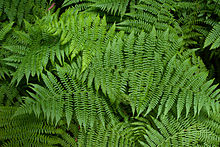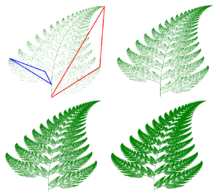利用者:LiterateGiggle/sandbox/barnsley fern
 |
ここはLiterateGiggleさんの利用者サンドボックスです。編集を試したり下書きを置いておいたりするための場所であり、百科事典の記事ではありません。ただし、公開の場ですので、許諾されていない文章の転載はご遠慮ください。
登録利用者は自分用の利用者サンドボックスを作成できます(サンドボックスを作成する、解説)。 その他のサンドボックス: 共用サンドボックス | モジュールサンドボックス 記事がある程度できあがったら、編集方針を確認して、新規ページを作成しましょう。 |

バーンズリーのシダはフラクタルのひとつで,最初に著書 Fractals Everywhere[1] で初めてこれを記述したイギリスの数学者マイケル・バーンズリーに因んで名付けられた.バーンズリーははじめシダの一種Asplenium adantum-nigrum(ミヤマカワリシダ?)に似せるように設計した.
歴史
[編集]バーンズリーのシダは自己相似性を持つ集合の基本的な例の1つである.つまり,数学的に生成されたパターンで,拡大・縮小をしても同様の形を見出すことができる.シェルピンスキーのギャスケットのように,バーンズリーのシダは計算機を用いて数式を繰り返し適用することで図形として美しい構造が作り出せることの好例である.バーンズリーの1988年の著書 Fractals Everywhere はジョージア工科大学で数学の学部生を教えた Fractal Geometry という講義に基づいていて,その出版後には次の講義 Fractal Measure Theory も編まれた[1].バーンズリーの業績は自然を数理的モデルで模倣しようとするグラフィックアーティストたちの着想の源のひとつとなっている.
バーンズリーによって書かれたシダのコードはフラクタルを作る反復関数系 (iterated function system, IFS) の一例である.これはコラージュ定理から従う.バーンズリーはフラクタルを用いて科学技術分野における様々な現象をモデル化したが,特に植物の構造について The fern code developed by Barnsley is an example of an iterated function system (IFS) to create a fractal. This follows from the collage theorem. He has used fractals to model a diverse range of phenomena in science and technology, but most specifically plant structures.
"IFSs provide models for certain plants, leaves, and ferns, by virtue of the self-similarity which often occurs in branching structures in nature. But nature also exhibits randomness and variation from one level to the next; no two ferns are exactly alike, and the branching fronds become leaves at a smaller scale. V-variable fractals allow for such randomness and variability across scales, while at the same time admitting a continuous dependence on parameters which facilitates geometrical modelling. These factors allow us to make the hybrid biological models... ...we speculate that when a V -variable geometrical fractal model is found that has a good match to the geometry of a given plant, then there is a specific relationship between these code trees and the information stored in the genes of the plant.
—Michael Barnsley et al.[2]
構成
[編集]
Barnsley's fern uses four affine transformations. The formula for one transformation is the following:
Barnsley shows the IFS code for his Black Spleenwort fern fractal as a matrix of values shown in a table.[3] In the table, the columns "a" through "f" are the coefficients of the equation, and "p" represents the probability factor.
| w | a | b | c | d | e | f | p | Portion generated |
|---|---|---|---|---|---|---|---|---|
| ƒ1 | 0 | 0 | 0 | 0.16 | 0 | 0 | 0.01 | Stem |
| ƒ2 | 0.85 | 0.04 | −0.04 | 0.85 | 0 | 1.60 | 0.85 | Successively smaller leaflets |
| ƒ3 | 0.20 | −0.26 | 0.23 | 0.22 | 0 | 1.60 | 0.07 | Largest left-hand leaflet |
| ƒ4 | −0.15 | 0.28 | 0.26 | 0.24 | 0 | 0.44 | 0.07 | Largest right-hand leaflet |
These correspond to the following transformations:
Computer generation
[編集]
Though Barnsley's fern could in theory be plotted by hand with a pen and graph paper, the number of iterations necessary runs into the tens of thousands, which makes use of a computer practically mandatory. Many different computer models of Barnsley's fern are popular with contemporary mathematicians. As long as the math is programmed correctly using Barnsley's matrix of constants, the same fern shape will be produced.
The first point drawn is at the origin (x0 = 0, y0 = 0) and then the new points are iteratively computed by randomly applying one of the following four coordinate transformations:[4][5]
ƒ1
- xn + 1 = 0
- yn + 1 = 0.16 yn.
This coordinate transformation is chosen 1% of the time and just maps any point to a point in the first line segment at the base of the stem. This part of the figure is the first to be completed in during the course of iterations.
ƒ2
- xn + 1 = 0.85 xn + 0.04 yn
- yn + 1 = −0.04 xn + 0.85 yn + 1.6.
This coordinate transformation is chosen 85% of the time and maps any point inside the leaflet represented by the red triangle to a point inside the opposite, smaller leaflet represented by the blue triangle in the figure.
ƒ3
- xn + 1 = 0.2 xn − 0.26 yn
- yn + 1 = 0.23 xn + 0.22 yn + 1.6.
This coordinate transformation is chosen 7% of the time and maps any point inside the leaflet (or pinna) represented by the blue triangle to a point inside the alternating corresponding triangle across the stem (it flips it).
ƒ4
- xn + 1 = −0.15 xn + 0.28 yn
- yn + 1 = 0.26 xn + 0.24 yn + 0.44.
This coordinate transformation is chosen 7% of the time and maps any point inside the leaflet (or pinna) represented by the blue triangle to a point inside the alternating corresponding triangle across the stem (without flipping it).
The first coordinate transformation draws the stem. The second generates successive copies of the stem and bottom fronds to make the complete fern. The third draws the bottom frond on the left. The fourth draws the bottom frond on the right. The recursive nature of the IFS guarantees that the whole is a larger replica of each frond. Note that the complete fern is within the range −2.1820 < x < 2.6558 and 0 ≤ y < 9.9983.
Mutant varieties
[編集]

By playing with the coefficients, it is possible to create mutant fern varieties. In his paper on V-variable fractals, Barnsley calls this trait a superfractal.[2]
One experimenter has come up with a table of coefficients to produce another remarkably naturally looking fern however, resembling the Cyclosorus or Thelypteridaceae fern. These are:[6][7]
| w | a | b | c | d | e | f | p |
|---|---|---|---|---|---|---|---|
| ƒ1 | 0 | 0 | 0 | 0.25 | 0 | −0.4 | 0.02 |
| ƒ2 | 0.95 | 0.005 | −0.005 | 0.93 | −0.002 | 0.5 | 0.84 |
| ƒ3 | 0.035 | −0.2 | 0.16 | 0.04 | −0.09 | 0.02 | 0.07 |
| ƒ4 | −0.04 | 0.2 | 0.16 | 0.04 | 0.083 | 0.12 | 0.07 |
References
[編集]- ^ a b Fractals Everywhere, Boston, MA: Academic Press, 1993, ISBN 0-12-079062-9
- ^ a b Michael Barnsley, et al.,“"V-variable fractals and superfractals"”. Template:Cite webの呼び出しエラー:引数 accessdate は必須です。 (2.22 MB)
- ^ Fractals Everywhere, table III.3, IFS code for a fern.
- ^ Barnsley, Michael (2000). Fractals everywhere. Morgan Kaufmann. pp. 86. ISBN 0-12-079069-6 2010年1月7日閲覧。
- ^ Weisstein, Eric. “Barnsley's Fern”. 2010年1月7日閲覧。
- ^ Other fern varieties with supplied coefficients, retrieved 2010-1-7
- ^ A Barnsley fern generator






